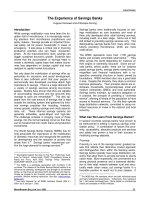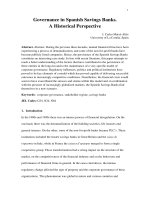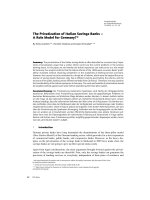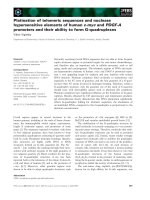200 YEARS OF SAVINGS BANKS: A STRONG AND LASTING BUSINESS MODEL FOR RESPONSIBLE, REGIONAL RETAIL BANKING pot
Bạn đang xem bản rút gọn của tài liệu. Xem và tải ngay bản đầy đủ của tài liệu tại đây (4.28 MB, 164 trang )
200 YEARS OF SAVINGS BANKS:
A STRONG AND LASTING BUSINESS
MODEL FOR RESPONSIBLE,
REGIONAL RETAIL BANKING
PERSPECTIVES
63
September 2011
200 YEARS OF SAVINGS BANKS:
A STRONG AND LASTING BUSINESS
MODEL FOR RESPONSIBLE,
REGIONAL RETAIL BANKING
The findings, interpretations and conclusions expressed in this paper do
not necessarily reflect the views of WSBI (World Savings Banks Institute) or
ESBG (European Savings Banks Group). Neither WSBI nor ESBG guarantee
the accuracy of the data included in this work. The material in this
publication is copyrighted.
TABLE OF CONTENTS
Foreword 7
Chapter 1: Savings Banks: From an Idea to an Institution 9
Henry Duncan and the Savings Bank Movement in the UK 11
Michael Moss, Professor of Archival Studies,
University of Glasgow
Savings and Economic Development: Sweden in the 19th Century
27
Enrique Rodriguez, Professor at the Center for Banking
and Finance and Senior Vice-President of Swedbank, and
Mats Andersson, Archivist, Swedbank
Savings Banks in Portugal: Origins and Attributes 49
Pedro Sameiro, Secretary General, Montepio
Chapter 2: Savings Banks: A Banking Model Worldwide 57
Why Does the U.S. Have a Weak Mutual Savings Bank Sector? 59
R. Daniel Wadhwani, Assistant Professor, University of the Pacific
The First Savings Banks in Latin America: Cuba and Puerto Rico 87
(1840-1898)
Angel Pascual Martinez Soto, Professor, University of Murcia
Savings Banks in the Asia-Pacific Region: A History 107
of Development
Pui-Tak Lee, Research Officer, Centre of Asian Studies,
University of Hong-Kong
Development and Diffusion of Savings and Savings Banks 125
in China: A Historical Perspective
Pui-Tak Lee, Research Officer, Centre of Asian Studies,
University of Hong-Kong
Do savings banks differ from traditional commercial banks? 141
Prof. Giovanni Manghetti, Chairman, Cassa di Risparmio
di Volterra
5
6
FOREWORD
This is a report on the “200 Years of Savings Banks: A Strong and Lasting
Business Model for Responsible, Regional Retail Banking” conference
held in Edinburgh on 10 June 2010. The conference focused on the past,
present and future of savings banks.
In 1810, Reverend Henry Duncan opened a savings bank in his small
parish in Ruthwell (Dumfries, Scotland). Two hundred years later, the
Edinburgh conference celebrated the savings bank in Ruthwell as a model
for modern savings banks and retail banking institutions that continue to
cater to the needs of European citizens, small and medium-sized
businesses and local authorities, and have evolved into dynamic financial
institutions that represent one-third of the current retail banking sector.
Chapter 1 of this report retraces the development of savings banks on the
European continent. The article by Prof. Michael Moss, author of a history
of savings banks in Scotland, focuses on Henry Duncan and the development
of the savings bank model in the United Kingdom. Two case studies of
savings banks follow: Prof. Enrique Rodriguez and Archivist Mats
Andersson focus on Sweden, and Montepio Secretary General Pedro
Sameiro focuses on Portugal.
Chapter 2 explores how savings bank ideals and principles have spread all
over the world. The institutions assumed different forms but share the
notion that banking is a tool for all and not a privilege for the few.
The report includes research by R. Daniel Wadhwani, Assistant Professor
at the University of the Pacific (USA), on the development of savings
banks in North America, followed by Martinez Soto, Professor at the
University of Murcia, who writes about the proliferation of savings banks
in Latin America, particularly Cuba and Puerto Rico, and in the Philippines.
Lastly, Prof. Pui-Tak Lee highlights the development of savings banks in
China, Japan and Korea.
7
8
In conclusion, Prof. Giovanni Manghetti reflects on savings banks in the
current financial crisis and elaborates on risks and future opportunities.
The report aims to stimulate and encourage research on the development
of savings and retail banks all over the world.
I hope this publication will be a source of inspiration for further research.
Chris De Noose
ESBG-WSBI Managing Director
CHAPTER 1: SAVINGS BANKS:
FROM AN IDEA TO AN INSTITUTION
10
11
Michael Moss, Professor Archival Studies, University of Glasgow
Michael Moss is a professor of archival studies in the School of
Humanities at the University of Glasgow. He was responsible for
surveying and rescuing the records of the savings bank movement
in Scotland and England before flotation. In collaboration with
Iain Russell, he was commissioned by Sir Nicholas Goodison,
Chairman of the TSB, to write a history of the movement, which
was published by Weidenfeld and Nicolson in 1994 as An
Invaluable Treasure: A History of the TSB. In 2000 he published a
history of Standard Life, the Edinburgh life assurance company,
which had similar values to those of the savings bank movement.
He is a member of the board of the National Archives of Scotland
and of the Advisory Council on Records and Archives.
Reverend Henry Duncan was born at Lochrutton,
Kirkcudbrightshire, on 8 October 1774, the third
son of the minister Reverend George Duncan.
Lochrutton is about six miles south-west of
Dumfries in south-west Scotland. In the late
18th century it had a population of some
550 people, who were engaged mostly in
farming. Reverend George Duncan complained
that the landowners showed no enthusiasm for
improving the agriculture of the parish, even
though there was a flourishing export trade with
the west coast of England. Henry Duncan was educated at Dumfries
Academy before attending St Andrews University for two sessions from
1788 to 1790. At the time it was common for children as young as 14 to
go to university, and for young men in general to spend a year or two at
university before entering a trade.
HENRY DUNCAN AND
THE SAVINGS BANK
MOVEMENT IN THE UK
Reverend Henry Duncan.
He left St Andrews in 1790 to take up a position as a junior clerk in the
Liverpool banking house of Arthur Heywood Sons & Co. The attraction of
Liverpool for Henry Duncan was that his two brothers were already
working there. However, unlike his brothers, he did not find the world of
commerce to his liking. His employers complained he devoted too much
time to literary pursuits and theological study. Deciding to follow his
father into the church, he returned to Scotland to take classes at
Edinburgh and Glasgow Universities where he was influenced by the
jurist John Miller and the moral philosopher Dugald Stewart. He went
back to Lochrutton in 1798 and the following year he was appointed
minister of Ruthwell where he was to remain for the rest of his life.
The weather in 1799 and 1800 in much of Scotland was cold and wet
and the harvest poor. Henry Duncan responded to the plight of his
congregation by arranging with his brothers to send supplies of Indian
corn from Liverpool, which he sold to the needy at cost price. In a spirit
of self-help, he encouraged women to take up spinning woollen yarn to
supplement their family income and employed destitute labourers on his
own land.
12
The church in Ruthwell, where Henry Duncan was minister.
Recognising that such measures offered only partial solutions to the
problems of poverty, he revived the local friendly society that had been
founded in 1795 and had quickly become moribund. He rewrote the
rules and regulations and improved its management. So successful was
this initiative that he formed another society specifically for women.
Soon over a quarter of the parish, some 300 people, were members of
the two societies. Opposed to compulsory taxation, to provide relief to
the poor and destitute, he was a passionate supporter of “self-help”.
Such attitudes begged the serious question as to whether the very poor
had sufficient marginal income to save, even in good times – a debate
that still continues between those who are committed to state-sponsored
social welfare and those who oppose it or at least wish to curtail the level
of spending. After the resumption of the war with France in 1803, the
price of food climbed and hardship, particularly in rural areas, became
more acute.
From 1808 Henry Duncan tried to inculcate ideals of thrift in the local
community by publishing a series of tracts and articles in the Dumfries
and Galloway Courier, which he had created with financial support from
his brothers. These had a strong moral message – the provident and well-
behaved could look forward to a secure independent future, while the
improvident and dissolute, especially the intemperate, could anticipate
ruin and destitution. Such moralising has continued to this day.
Despite the success of the friendly societies, Duncan was not convinced
that their rules and regulations, which required regular subscriptions,
were appropriate, for they entailed collecting the uncertain savings of
the poor. This led him to propose that savings banks with very
simple regulations should be opened in every parish in Scotland.
Although Scotland’s banking system, with interest bearing accounts, was
more advanced than those of other countries, it did not provide services
to individuals with only small amounts to deposit, and who were thus
often obliged to keep their savings in cash or lend them in the local
money market, which could be very risky. In May 1810 Henry Duncan
opened the Ruthwell Savings Bank in the Friendly Society’s rooms.
13
14
Deposits were invested in
commercial bank interest-bearing
accounts. In a practice that
became familiar in Scotland, the
Kirk Session (the church elders)
and the minister were trustees,
while prominent locals were
extraordinary members of the court
of directors. Ordinary members
had to make an initial deposit of GBP 1, while extraordinary members
had to pay GBP 2 and honorary members GBP 5. This was very prescient
of
Henry Duncan, as the better-off depositors made only occasional
additional
deposits and almost no withdrawals, while ordinary members
could be expected to make a large number of small deposits. The subsidy
of small depositors by those with large balances persisted and was
eventually a factor in the erosion of the savings bank ideal that led
inexorably to privatisation.
In deciding to open the Ruthwell
Savings Bank, Henry Duncan drew
on the experience of other savings
schemes and friendly societies.
In 1797 the utilitarian philosopher
Jeremy Bentham proposed the
establishment of what he called
“Frugality Banks” or savings banks
that would pay interest on
deposits and that would be built
and managed by a proposed
National Charity Company.
The following year Mrs Priscilla
Wakefield established a Female
Benefits Club incorporating a Children’s Bank in the parish of Tottenham
to the north of London.
Anybody could open an account for a child by making regular monthly
contributions of a penny or more. At the turn of the century she
converted her Female Benefit Club into a Benefit Bank, recognised at the
time “as the first distinct Bank for Savings publicly set on foot for the
benefit of the lower classes”. The Wakefields were a remarkable family.
Her son Edward Gibbon Wakefield pioneered emigration to the
Antipodes as a way of reducing the cost of poor relief.
Deposit box of the Ruthwell Parish Bank.
The Wakefield family, with Mrs Priscilla
Wakefield who created the ‘first distinct
Bank for Savings publicly set on foot for
the benefit of the lower classes’.
15
The political economist Thomas Malthus, in the second edition of his
celebrated 1803 Essay on the Principles of Population, writes, “To facilitate
the saving of small sums of money for this purpose [he is referring to the
purchase of a cow] and to encourage young labourers to economise their
earnings with a view to a provision for marriage, it might be extremely
useful to have County Banks, where the smallest sums would be received
and a fair interest granted for them”. He elaborated on these ideas in the
1817 fifth edition, going so far as to suggest that by postponing marriage
until sufficient capital had been accumulated there would be less need
for the state to support needy families, as there would be fewer of them.
Although he admitted that such a transition could not be effected
quickly, his concept of “saving a portion of present earnings for future
contingencies” has remained the bedrock of much of the rhetoric of
thrift and providence ever since. Nevertheless, he later recognised that
“the principle of saving taken to excess would destroy the motive to
production”. While he extolled saving “as a most sacred private duty”,
he had doubts about its public application, which a century later
economist J. M. Keynes crystallised into his well known paradox of thrift:
“a private virtue and a public vice”.
In 1804 George Rose, a member of Parliament for Christchurch and vice-
president of the board of trade, called for imaginative ideas to help solve
the intractable problem of poverty. He was later to play a crucial role in
promoting the savings bank ideal. Within a year John Bone responded to
this challenge by advocating the abolition of poor relief and, along with
what amounted to sheltered accommodation for old people, suggested
that “a Bank should be opened to receive the small savings of the youth
of both sexes, who have no dependence but their labour and economy,
and to return them on the day of their marriage with the interest and
premiums proportional to the amount”. With wartime inflation running
high, Patrick Colquhoun, a stipendiary magistrate in London, expanded
on these ideas by outlining a scheme for a National Deposit Bank for
Parochial Savings managed and guaranteed by the government. The bank
would be a powerful force for social change and “unquestionably give a
new and more provident character to menial servants and thereby rescue
females from the walks of prostitution”. Samuel Whitbread, the reforming
member of Parliament for Bedford, attempted to introduce legislation to
establish a national savings bank based on post offices. There were other
local initiatives, such as the West Calder Friendly Bank outside Edinburgh
established by Reverend John Mackersy in 1807, and at Bath, in south-west
England, a society was formed in 1808 to attract the savings of servants.
16
Such concepts and developments were critical in shaping Henry Duncan’s
ideas for the parish bank in Ruthwell. What set him apart from the others
who could lay claim to be the founder of the savings bank movement,
such as Priscilla Wakefield, was his unstinting effort to publicise his
achievement and promote the formation of savings banks in every parish
in Scotland. Because the concept of thrift and self-help had been so
heavily promoted and followed, additional banks were formed
spontaneously both in Scotland and England. John Henry Forbes, the son
of the Edinburgh banker Sir William Forbes, promoted a savings bank as
a branch of the City’s Society for the Suppression of Beggars, in 1813.
When GBP 10 had been deposited it was to be transferred to Sir William
Forbes & Co. Within less than two years the bank had almost 750
subscribers. In England the Liverpool Mechanics, Servants & Labourers
Fund was founded in 1812 and the Bristol Savings Bank the following
year. By the time these banks were beginning to make an impact, the war
with France was over.
The sudden cessation of government wartime expenditure after the
victory at the Battle of the Nations in 1814 triggered a catastrophic
economic recession that was compounded by appalling weather due to
exceptional volcanic activity. Confronted by unprecedented demand for
poor relief, parishes throughout the United Kingdom looked for ways to
reduce the burden, especially by encouraging saving. During 1815 several
savings banks were formed in Scotland and England, which were
modelled on the ideas of Henry Duncan and other commentators.
In England, where there was no tradition of commercial bank interest-
bearing accounts, deposits were invested in government stock, which
became common practice. As the savings movement in England gathered
pace during the remainder of the decade, its principal advocate was
George Rose, who was still a member of Parliament for Christchurch and
an effective publicist with strong links to the national press. Unlike Duncan,
Rose was a Tory who believed savings banks “would gradually do away
with the evils of the system of poor laws”. His Observations on Banks for
Savings, published in 1816, relied heavily on the example of Forbes’s
Edinburgh bank and ignored Henry Duncan’s Ruthwell venture.
17
Rose was vehemently attacked by William Cobbett, the social reformer
and political thinker, who again warned that the poor lacked the
marginal propensity to save. Nevertheless, in 1817 Rose successfully
introduced legislation “to encourage the Establishment of Banks for
Savings in England”. All deposits in England and Wales were to be placed
on account with the Commissioners of the National Debt which would
pay interest at the rate of just over 4.5% per annum.
The purpose of this substantial premium on the prevailing rate on
government stock was to attract savers. The principals of this legislation
were to remain in force until privatisation, and in some senses George
Rose can lay claim to being the founder of the savings bank movement.
Although Henry Duncan came to London to advise Rose, the legislation
did not apply to Scotland, as Duncan and his fellow Scots wished to
retain the ability to place deposits with commercial banks.
Government protection stimulated a wave of publications supporting the
savings ideal. By the close of 1817, 101 savings banks had opened in
England and Wales with more than GBP 250,000 in deposits, with an
additional 125 banks established in the following year. In his 1818 Annals
of Banks for Savings the political reformer and radical Sir Francis Burdett
saluted Henry Duncan as having founded the first successful savings bank
and fully supported his vision of a future Utopia, with savings banks at
the centre ensuring an absence of poverty. The experience of the banks
did not support the naivety of this rhetoric. The majority of savers
were drawn from the ranks of shopkeepers, skilled craftsmen, domestic
servants, school teachers, farmers, and their wives and children,
confirming that there was a genuine gap in the financial market for the
surplus income of wage earners. However, this initial experience
corroborated the opinion of commentators, such as William Cobbett,
that savings banks would do nothing to reduce expenditure on poor
relief, which indeed proved to be the case. Ironically, the government
could be encouraged in a period of heightened political tension, as it was
argued that depositors were unlikely to be radicalised or to rebel if their
savings were invested in guaranteed public funds, as many savers were
artisans, who were most prominent in the radical causes supported by
Sir Francis Burdett.
18
As the concept of saving amongst those who had benefitted from the
rapid industrialisation of the late 18th century took hold, so the rhetoric
shifted towards self-improvement and self-help for the “respectable
classes”. Inextricably linked to “self help” was the emerging temperance
movement. Temperance literature contrasted the ruin that accompanied
overindulgence in drink and riotous living with the prosperity that
accompanied saving and temperate behaviour.
Much of this literature was directed at women and children, who were
portrayed as the victims of male dissolution. Henry Duncan shared such
concepts and they came increasingly to colour his later writings, in which
the dissolute drunkard could anticipate the direst consequences, even
public execution. Scotland was also home to the first Sunday school in
the United Kingdom, in Glasgow, in 1815-16, and the first temperance
society, in Greenock, in 1829. Just like the savings banks, Sunday schools
and temperance societies were quickly established throughout the United
Kingdom, attracting large numbers of supporters. As enthusiasm for the
twin gospels of “self-help” and temperance grew, so did concern that
the government was subsidising the savings movement by paying interest
at an above-market rate, particularly as the anticipated decrease in poor
relief had not materialised. In 1829 interest rates were cut and the ceiling
on annual and total deposits reduced, leading to a decline in savings.
This was followed in 1834 by a root and branch reform of the Poor Law
in England and Wales, largely designed to save money. The ability to
deposit funds with the Commissioners of the National Debt was
extended to Scotland the following year in an effort to revitalise a
movement that was in danger of becoming moribund.
Although the new Poor Law paid lip service to the savings movements,
the connection between poor relief and savings was now broken and
when in 1844 interest rates were cut again there was almost no mention
of the social benefits of the savings banks. There was suspicion in
government circles that those better off were taking advantage of the
generous rates paid on deposits in savings banks. This was a contradiction
implicit in the savings banks from the outset. To finance their services
they needed major depositors who exercised few transactions.
19
Henry Duncan died in 1846 at age of 72. A true son of the Scottish
Enlightenment, his interests were wide ranging, encompassing
antiquarian pursuits, drawing, modelling, sculpture, gardening and
architecture. In his later years, he could take satisfaction that he had been
in some sense the progenitor of a movement that now covered the whole
of the United Kingdom, even though its customer base and purpose was
fundamentally different from his original concept, with the one exception
that “saving for a rainy day” was to remain a core value until the coming
of the welfare state in the early 20th century.
After his death the savings movement and friendly societies were hit by
a succession of frauds that damaged their standing and restricted
progress. By 1861 there were 645 individual banks with total deposits of
GBP 41 million. Two years earlier, the concepts of thrift and improvement
had received a ringing endorsement in Samuel Smiles’s best-selling book
Self Help, which has never been out of print
since. To a modern reader the text may seem
overburdened with Victorian platitudes from the
opening sentence (“Heaven helps those who
help themselves”). Like Henry Duncan, Samuel
Smiles was a Scot who chose medicine rather
than the church as a career, but abandoned his
calling in favour of the insurance industry.
In his view the struggle to live prudently was an
achievement because man’s natural state was
prodigality. Saving was for him a matter of
investment that provided the opportunity to
work, which for all its tedium was honourable.
The notion that there was a moral duty to save
was novel: “A penny is a very small matter, yet the comfort of thousands
depend upon the proper spending and saving of pennies”. Smiles has
been criticised by left-wing historians, who condemn him as a champion
of an unbridled selfish capitalism. Such attacks overlook his efforts to
illustrate the rhetoric of “self-help” with well chosen examples from all
walks of life that tempered hedonistic self-interest with a mutual respect
for others.
Samuel Smiles, author
of the best-selling book
Self Help.
20
Smiles had much in common with Henry Duncan, believing that the role
of government was to be a benevolent spectator of its hard-working,
industrious and thrifty citizens. His rhetoric struck a chord with many but
was not entirely shared by the Liberal government of William Gladstone,
which in 1861 established the Post Office Savings Bank to complement
the savings banks and achieve nationwide coverage through the network
of sub-post offices. Many in the savings bank movement distrusted the
government’s motives, perceiving the Post Office Savings Bank as a
competitor, which indeed proved to be the case. By the close of 1862 the
Post Office Savings Banks had attracted over 178,000 customers and
total deposits of almost GBP 1.7 million at the expense of savings banks,
which experienced a sharp decline in the number of depositors
throughout the country. There was an urgent need for the movement to
speak with a common voice. A national extension committee was formed
in London in 1862 and led in 1886 to the formation of the Trustee
Savings Banks Association. Savings banks were facing competition not
only for small deposits from the Post Office, but also for their greater,
customary role from commercial banks that were seeking additional retail
deposits through evolving branch networks to shore up their balance
sheets. Savings banks were unable to offer competitive rates of interest
on their current accounts.
With competition from commercial banks and an increasing volume of
transactions, savings banks had to find ways of offering higher interest
rates to their major depositors, on whom they depended to meet their
overheads. A legislative provision enabled them to do this by opening
special investment accounts that were invested in local government
stocks, which paid higher returns than the National Debt Commissioner.
During the 1870s the savings banks and thrift movement in general
gained ground in the north of Britain, particularly Scotland, while it lost
ground to the Post Office Savings Bank in the south. This was to have
important consequences in Scotland and northern counties, which were
synonymous with provident institutions. Several savings banks closed.
One victim was the bank at Ruthwell which in 1875, faced with a
dwindling number of depositors, amalgamated with the Annan Savings
Bank that eventually was acquired by the Royal Bank of Scotland.
21
By the mid-1880s attitudes were beginning to change, with social
commentators and philosophers, such as T. H. Green, arguing that personal
freedom could only be achieved through a degree of state direction and
control and by finally laying to rest the notion that the poor had a
marginal propensity to save. This was very different from Samuel Smiles’s
conviction that hardship and struggle allowed an individual to escape
from a natural state of prodigality into one of self-determination.
Such ideas were confirmed by the first systematic social surveys
conducted in the 1890s, and led in turn to the beginnings of the welfare
state by the Liberal government just before the outbreak of the First
World War and to the emergence of the Labour Party. With the rhetoric
of thrift off the political agenda, the government could afford to allow
the Post Office Savings Bank, aimed directly at the poorest in society, and
the savings banks, whose customer base was better-off, to coexist. In the
southern half of Britain the result was that more savings banks closed and
handed over their funds to the Post Office, while in the north they
prospered, helped by rising real wages and increases in both the annual
limit on deposits and the ceiling on total deposits. Once again, craftsmen
and artisans fuelled an increase in business, particularly in the economy’s
service and tertiary sectors. Saving by and for children also grew. By 1899
the savings banks had achieved a 7% market penetration. Much of this
growth seems to have been driven more by saving for a short-term
purpose – for example, holidays and entertainment – than for the long
term. In the century’s prosperous final decade a rise in savings occurred
throughout the thrift movement, accompanied by a huge increase in the
membership of friendly societies and a sharp rise in the sale of life
insurance products. In the face of criticism of their rhetoric by social
commentators, the movement questioned its purpose but was
encouraged to persist when analysis showed that the majority of
customers held small deposits of about GDP 10.
The long recession that began at the turn of the century and lasted for
almost a decade confirmed Keynes’s observation that the propensity to
save correlates with disposable income. By 1905 total withdrawals of
savings exceeded deposits but turnover did not decline, suggesting that
savings accounts were being used effectively as a form of current
account. There were those who rejected a Keynesian explanation for a
decline in savings ratios during periods of austerity and preferred to
blame Edwardian Britain’s extravagant spending on luxuries and
amusements.
22
Many in the savings bank movement clung to the old rhetoric that for
most families thrift was an essential virtue that safeguarded health and
happiness. Such ideas were finally debunked by evidence presented in
1906 to the Royal Commission on the Poor Laws and Relief of Distress by
Charles Booth, who from his detailed investigations of household
incomes showed that a large part of the population “ha[s] not the
ambition or the ability to establish out of their wages a fund to which
they may turn in times of stress”. In keeping with these findings many
savings banks ceased to promote thrift as a way out of poverty, but
instead attacked extravagance, amusements, gambling and particularly
overindulgence in alcohol. The National Insurance Act of 1911 provided,
for the first time, health insurance and unemployment benefits to those
engaged in certain cyclical industries, and paved the way for the
introduction of old age pensions. Although the state might have
appeared to be taking over the original role of the savings movement,
the Liberal government went out of its way to emphasise that thrift was
no less the handmaid of the new welfare state, as “a new and very
general desire will arise among men to augment the State allowances,
which is theirs in certain emergencies, by some effort of their own, for
they will have the State’s assurance that sickness and unemployment,
the grim spectres which have hitherto confronted working men, will not
rob them of a penny of their savings”.
The progress of welfare reform, including the introduction of old age
pensions, was interrupted by the First World War. Extensive campaigns
organised by the National War Savings Committee reached a crescendo
in 1918 and were designed in part to cool the economy by deferring
spending until the war was over.
With the coming of peace Thomas Henderson of the Savings Bank of
Glasgow articulated a widely accepted view when he wrote: “To many
thoughtful minds in the savings bank movement it has been apparent for
some time that, if savings banks are to maintain their hold upon the
community, then they must adapt their methods to the changing needs
of the day, they realise that the old conceptions of their functions which
was limited very largely to making provision for a rainy day, must give
place to a wider conception and meet, more adequately, present day
requirements”. The managers of the Coventry Savings Bank were struck
by the number of depositors who withdrew savings in 1925 to buy
houses: “The purchase of a house is an excellent use to make of savings, and
the most satisfactory way of doing so is to save the money to pay for it”.
23
As enthusiasm for house ownership swept Britain, particularly the south
of England, savings banks could not match the growth of building
societies in attracting depositors, usually with much higher rates of
interest. They were not, however, eclipsed and the number of depositors
and total deposits continued to grow, while those of the Post Office
Savings Bank fell. During the economic slump of the early 1930s savings
banks went to great lengths to counter Keynes’s claim that depositors
were saving when they should have been spending. They could be
forgiven, as advice from economists was conflicting and thrift remained
very much part of the government agenda, through the National Savings
Campaign. However, a debate emerged over what might be the
appropriate level of savings at various points of the economic cycle.
Before this argument was resolved, Hitler had come to power and Britain
once more found itself at war and desperate for savings to support the
war effort. The saving campaign continued after the war, during the long
period of austerity that lasted into the early 1950s and witnessed a fall in
saving ratios from 10% in 1945 to less than 3% in 1950. Under the post-
war Labour government the welfare state was extended with the creation
in 1948 of the National Health Service and a costly programme of
nationalisation of essential services and industries. Against this
background the whole savings movement had no alternative but to
return to the interwar rhetoric of saving for future consumption – for a
purpose, particularly the purchase of household goods and for holidays
and recreation. The Oxford Savings Bank was typical in telling depositors:
In many cases saving through the Bank is for short periods only, but
the Committee believes that the type of savings, for example, to meet
commitments for household expenditure, or for holidays or
Christmas, is a form of Thrift no less valuable than the old established
conception of saving as being the accumulation of small sums over a
longer period of years, often with no particular end in view.
Experience has shown that the short-term saver, having learnt the
values of his short-term saving, becomes a long-term saver.
24
This did not mean that the old rhetoric was completely abandoned, as it
could be applied to both long- and short-term savers. Advertisements still
contrasted the contented provident saver with the dismal improvident.
The predominance of short-term saving aligned savings banks much
more closely with commercial retail banks that by now had greatly
extended their branch network and were competing directly for deposits,
particularly those of larger better-off customers, which made it difficult
for savings banks to service smaller accounts.
The 20 years from 1950 to 1970 can best be characterised as an unequal
struggle between the whole of the thrift movement in the United
Kingdom and commercial banks that were rapidly extending their
services to retail customers who were themselves coming to expect a
range of financial services that savings institutions lacked the power to
provide. Savings banks responded by amalgamations that were
stimulated by the need to automate processes to reduce the cost of
managing thousands of small accounts and the need to introduce
movement-wide services, such as cheque payment, which often required
either legislation or government approval.
As is well known, this led inexorably to the amalgamation of nearly all the
banks into regional groupings and finally into a single, broader UK
organisation – the TSB, which was floated on the stock exchange in
1986. Although the decision to float rather than leave the TSB as a
mutual organisation was taken by the Conservative government, which
was opposed to any involvement by the state in the market for financial
services, with hindsight it would probably have happened in any event.
The problem for the TSB and its managers was that they lacked any
experience of commercial banking and most of the capital raised at
flotation, which was much in excess of capital requirements, was lost in
very risky ventures into merchant banking and insurance. After a period
of reorganisation and restructuring around its core business of retail
financial services, Lloyds Bank, an established UK commercial bank,
acquired TSB in 1995 and traded under the name Lloyds TSB until 2009,
when it was renamed Lloyds Banking Group. This transition from a
network of savings banks of various sizes with deep local roots into a fully
fledged commercial bank was painful and not without its critics. A recent
report from the Lloyds Banking Group suggests that far from being dead
the old rhetoric of thrift is alive and well: in the current downturn,
household saving is at its highest ever level and pension and welfare
payments much reduced. In other words, people are saving for a rainy
day, which Henry Duncan would have approved.
25
Bibliography
n Ahiakpor, J. C. W. (1995), “A Paradox of Thrift or Keynes’s
Misrepresentation of Saving in the Classical Theory of Growth?”,
Southern Economic Journal, 62 (1) 16-33.
n Bone, J. (1806), The Principles and Regulations of Tranquillity; an
institution commenced in the metropolis for encouraging and
enabling industrious and prudent individuals in the various classes of
the community to provide for themselves, etc., London, J. Asperne.
(1807), The Friend of the People: or, Considerations addressed
principally to persons of small incomes recommending them to
adopt some more effectual measures for securing their own
independence than those proposed to parliament by Mr. Whitbread,
are calculated to promote, London, M. Jones.
(1807), The Wants of the People, and the Means of the Government;
or, Objections to the interference of the legislature in the affairs of the
poor, as recommended by Mr. Whitbread in the House of Commons,
etc., London, Jordan & Maxwell.
n Colquhoun, P. (1796), A Treatise on the Police of the Metropolis,
explaining the various crimes which are felt as a pressure upon
the Community, and suggesting remedies for their prevention,
London, Dilly.
(1806), A Treatise on Indigence, London, J. Hatchard.
n Duncan, H. (1815), An essay on the nature and advantages of Parish
Banks: together with a corrected copy of the rules and regulations of
the Parent Institution in Ruthwell: and directions for conducting the
details of business, etc., Edinburgh.
n Finlayson, G. (1994), Citizen, State, and social welfare in Britain 1830-
1990, Oxford, Clarendon Press.
n Gosden, P. H. (1961), The Friendly Societies in England 1815-1875.
Manchester, Manchester University Press.
n Halifax 50 Years of Savings report (2010), available online at
/>190610Halifax_50_years_of_savings_report.pdf?WT.ac=018.
n Hobsbawn, E, J. (1962), Age of Revolution 1789-1848, London,
Weidenfeld and Nicolson.
n Horne, O. (1947), A History of Savings Banks, Oxford, Oxford
University Press.
n Keynes, J. M. (1936), The General Theory of Employment Interest and
Money, London, Macmillan.









